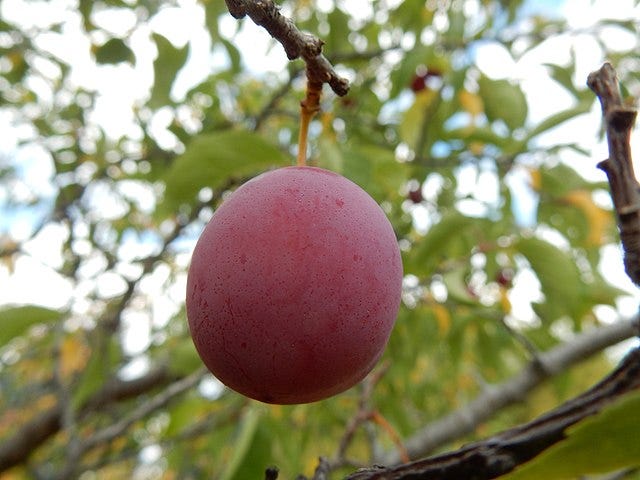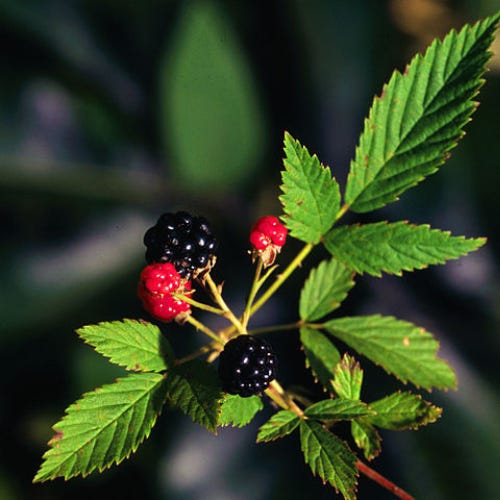Written by: Nursery Natives
Virginia is rich with biodiversity, culture and history — the soil is our greatest connector.
Native flora has fed ecosystems and communities here for thousands upon thousands of years, yielding fruit that is unimaginably delicious and uniquely adapted to the land.
Although the following list of 25 Native Fruit only represent a small portion of native edibles in Virginia, our hope is that this resource may serve as a starting point or supplement for your ongoing learning and wellness. Please enjoy, and take your time when attempting to identify new plants!
The vote for Virginia’s State Fruit is OPEN NOW until September 2023! Join in, and help decide which native fruit will represent our wondrous state!
Pawpaw (Asimina triloba) - a forager’s treasure, native across most of the commonwealth! Shawnee peoples referred to this delectable indigenous fruit as “ha’simini”, lending roots to its scientific derivative “Asimina”. Also known as, the Indiana Banana and America’s Forgotten Fruit, the story and importance of this marvelously tasty native is still being written. Subscribe here for more info. on the Pawpaw and current nursery availability.


Map
Canadian Serviceberry (Amelanchier canadensis) - a favorite of native pollinators, wildlife and humans alike, this early-blooming understory tree offers year-round, including one of the tastiest berries you’ll ever sink your teeth into.


Mountain Highbush Blueberry (Vaccinium simulatum) - wild blueberries come in all shapes and sizes, with exceptional flavor and health benefits! Virginia’s ranging landscapes are home to an array of blueberry species, including this Blue Ridge delight.


American Persimmon (Diospyros virginiana) - this splendid native fruit transitions from barely palatable to scrumptious divinity as it ripens, often hanging on deep into the winter months!


Red Mulberry (Morus rubra) - as a result of hybridization with nonnative mulberries, the Red Mulberry has become rarer and rarer since the introduction of the white mulberry, when settlers endeavored to bring the silk trade to North America. Although silk worms tend to prefer Morus alba, the native Red is something to cherish.


Chickasaw Plum (Prunus angustifolia) - native to a large swath of Virginia, the Chickasaw is one of several species of indigenous wild plums. While they are roughly half the size of store bought plums, they are incredibly flavorful and loaded with vitamins!


Black Cherry (Prunus serotina) - widely distributed by native wildlife, this pioneer species is tasty and abundant around much of the commonwealth. As just one of a few indigenous cherries, the Black Cherry commonly shares the soil with others, such as the delecious, appalachian favorite: the Pin Cherry.


Common Elderberry (Sambucus nigra) - much more than a just a superfruit! Elderberry is widely studied and widely enjoyed by wildlife and humans alike, packing immense flavor and enormous nutrional benefits. While the Red Elderberry is also a Virginia native, sprinkled across much of the Blue Ridge, Sumbucus nigra is much more prevalent across the state as a whole.


Wild Strawberry (Fragaria virginiana) - although wild strawberries are much smaller than those you may see at the supermarket, they are tasty nonetheless! Importantly, the color of the bloom tells the story of its edibility, as a yellow blossum is that of the nonnative and poisonous Potentilla indica.


Sugarberry (Celtis laevigata) - also known as Southern Hackberry, don’t let the distinct, worty bark scare you off! The Sugarberry proroduces a smaller fruit that resembles that of dates in taste, sometimes hanging on as foragers delight into the winter months.


Allegheny Blackberry (Rubus allegheniensis) - widespread along many Virginia roadsides, blackberries are significant sources of food for local pollinators and incredibly tasty according to most humans!


Flowering Raspberry (Rubus odoratus) - also known as the “Purple-flowering Raspberry”, this appalachian beauty is one of three raspberry species that are native to Virginia.


Cranberry (Vaccinium macrocarpon) - as one of two species of cranberry indigenous to Virginia, this larger, and, perhaps, more recognizable fruit is considered native to just seven counties across the commonwealth.


Virginia Ground-cherry (Physalis virginiana) - while humble in stature, the ground cherry is one to know. Its juicy, almost tropical flavor is sometimes compared to pinneapple with the texture of a grape.



American Beauty-berry (Callicarpa americana) - this multi-functional dream is desirable for landscapers due to its repellent properties as well as home bakers for its sweetly unique berries, utilized in jams, syrups and much more!


Black Huckleberry (Gaylussacia baccata)


Purple Passionflower (Passiflora incarnata)


Sweet Crabapple (Malus coronaria)


Muscadine Grape (Vitis rotundifolia)


Scarlet Hawthorn (Crataegus coccinea)




Choke Cherry (Prunus virginiana)


Sparkleberry (Vaccinium arboreum)






To learn about other native fruit such as the Chokeberry, Black Haw, Deerberry, Dog-hobble, Bearberry and Partridge-berry, check out Feeding Appalachia and Appalachian Culture Month 2023!
Thank you to the Virginia Native Plant Society (VNPS), Viginia Botonical Associates, Wiki Commons, Canva and Planetary Produce for providing phenomenal resources and energy towards the restoration of ecological health!
The vote for Virginia’s State Fruit is OPEN NOW until September 2023!
To continue learning and staying connected, subscribe FOR FREE with Nursery Natives :)
-
Virginia Botanical Associates. (2023). Digital Atlas of the Virginia Flora (http://www.vaplantatlas.org). c/o Virginia Botanical Associates, Blacksburg.




